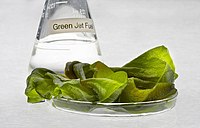
Photo from wikipedia
Prymnesium parvum is an environmentally harmful algae and well known for its toxic effects to the fish culture. However, there is a dearth of studies on the growth behavior of… Click to show full abstract
Prymnesium parvum is an environmentally harmful algae and well known for its toxic effects to the fish culture. However, there is a dearth of studies on the growth behavior of P. parvum and information on how the availability of nutrients and environmental factors affect their growth rate. To address this knowledge gap, we used a uniform design approach to quantify the effects of major nutrients (N, P, Si and Fe) and environmental factors (water temperature, pH and salinity) on the biomass density of P. parvum. We also generated the growth model for P. parvum as affected by each of these nutrients and environmental factors to estimate optimum conditions of growth. Results showed that P. parvum can reach its maximum growth rate of 0.789, when the water temperature, pH and salinity is 18.11 °C, 8.39, and 1.23‰, respectively. Moreover, maximum growth rate (0.895–0.896) of P. parvum reached when the concentration of nitrogen, phosphorous, silicon and iron reach 3.41, 1.05, 0.69 and 0.53 mg/l, respectively. The order of the effects of the environmental factors impacting the biomass density of P. parvum was pH > salinity > water temperature, while the order of the effects of nutrients impacting the biomass density of P. parvum was nitrogen > phosphorous > iron > silicon. These findings may assist to implement control measures of the population of P. parvum where this harmful alga threatens aquaculture industry in the waterbodies such as Ningxia region in China.
Journal Title: Scientific Reports
Year Published: 2021
Link to full text (if available)
Share on Social Media: Sign Up to like & get
recommendations!